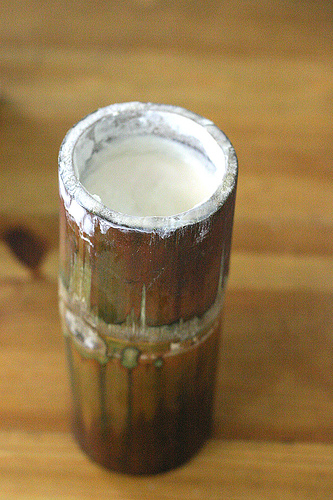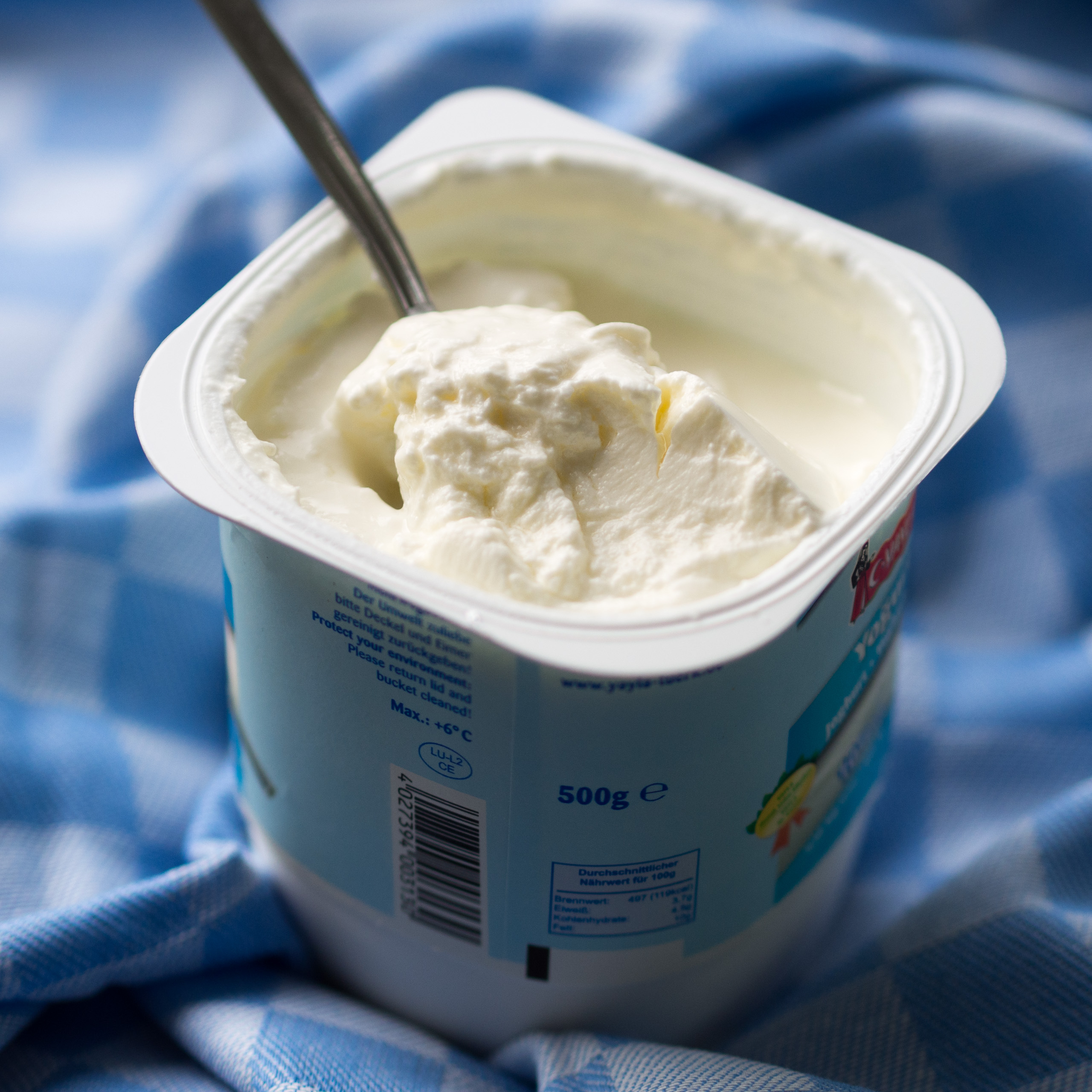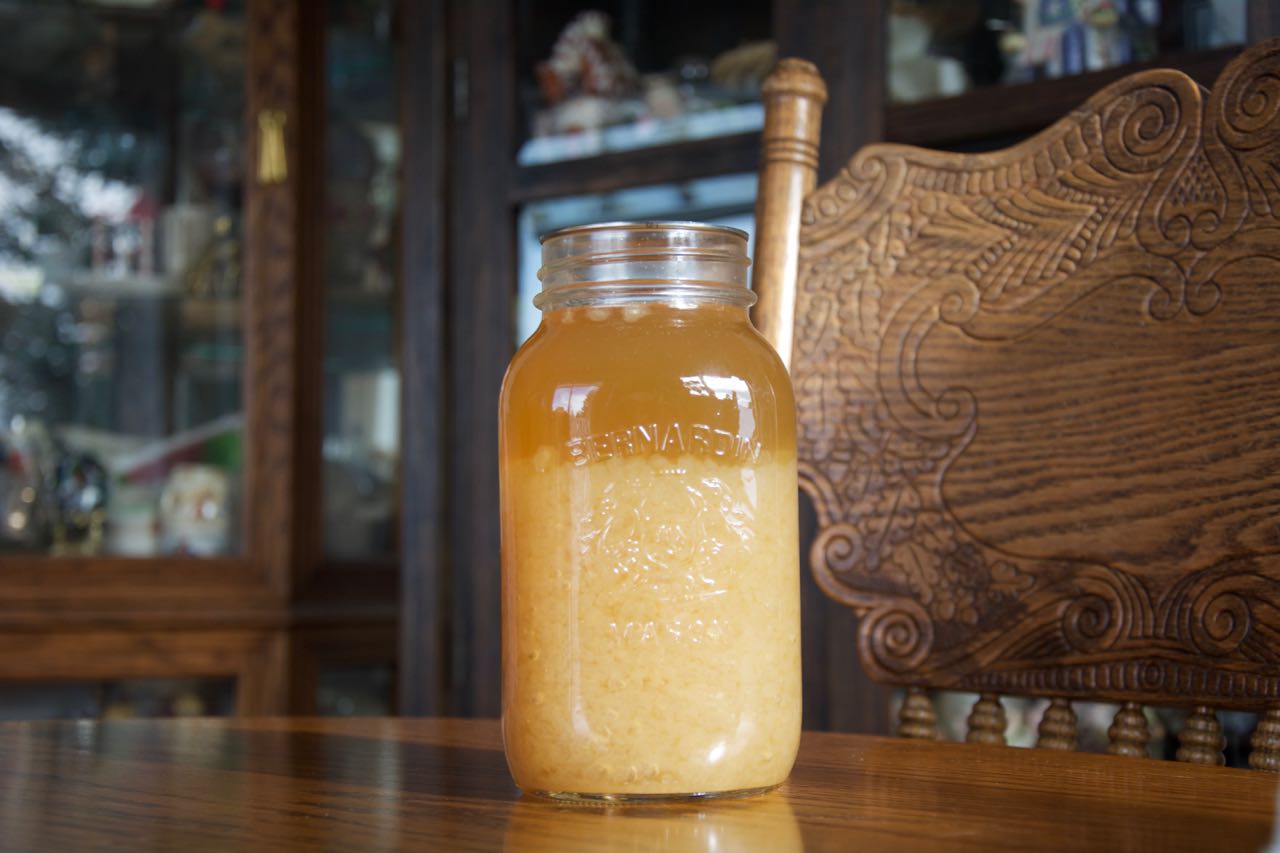|
Doogh
Doogh () is a cold and savoury Iranian drink. It is made with fermented milk. Unlike its sister beverage of Turkish origin, ayran, Doogh is not diluted yogurt. According to the Iranian Ministry of Food Standards, Doogh "is a drink resulting from lactic fermentation of milk whose dry matter is standardized by diluting yogurt (after fermentation) or buttermilk (before fermentation)." Production Milk and plain yogurt, at a ratio of 15:1, are mixed and placed on low heat until uniformly warm. Salt is added and the mixture is poured into a closed container and placed in a warm area for 3–4 days, after which it is ready to serve. The longer the drink is left to ferment, the more savoury it becomes. Many subcultures in Iran prefer a longer fermentation period. Etymology Doogh has historically been referenced in Persian literature as the representation of a "sour version" of milk. The history of this word is uncertain. It is present in Avestan scripture, and essentially seems t ... [...More Info...] [...Related Items...] OR: [Wikipedia] [Google] [Baidu] |
Ayran
Ayran ( ) is a cold savory yogurt-based beverage that is consumed across Central Asia, and the Balkans, in Turkey and Iran. The principal ingredients are yogurt, water and salt. Herbs such as mint may be optionally added. Some varieties are carbonated. It is a national drink of Turkey. Etymology ''Ayran'' (cf. '' airag'' in Mongolian: ' mare milk', ' () in Chuvash: 'buttermilk') is mentioned in Mahmud al-Kashgari's 11th century '' Dīwān Lughāt al-Turk'', although he did not give any information how ayran was made. The word is derived from the Old Turkic root ("to separate"), cf. Turkish ("to separate"). Preparation Ayran is served chilled and often as an accompaniment to grilled meat, bread or rice, especially during summer. It is made by mixing yogurt with chilled or iced water and is sometimes carbonated and seasoned with mint. It has been variously described as "diluted yogurt" and "a most refreshing drink made by mixing yogurt with iced water". The traditiona ... [...More Info...] [...Related Items...] OR: [Wikipedia] [Google] [Baidu] |
Ash-e Doogh
Ash-e doogh () is a yogurt soup found in various parts of Iran, Azerbaijan and Shiraz, with differing but similar ingredients. It is a kind of Aush. Similar dishes are found all over West Asia. Etymology :''See Aush§Etymology'' The spelling of the name of this dish varies in English and can include ''ash-e dugh''. There are some alternative terms for this soup, including ''ash-e mast''. ''Doogh'' in ''ash-e doogh'' means "yogurt", while ''ash-e'' is a form meaning "A(u)sh of", meaning ''A(u)sh (made) of/from yogurt. Ingredients Ash-e doogh is a soup usually made with yogurt or doogh, as well as different kind of herbs (such as coriander, leek, tarragon, mint, and parsley), vegetables (such as spinach, purslane, chickpeas, peas, onion and garlic), lamb meatballs, eggs, rice, salt and several types of spices. Fried mint with oil (and sometime garlic) is used as a topping for the soup. This soup can be made vegetarian. Variations Some people prefer to make this soup with yog ... [...More Info...] [...Related Items...] OR: [Wikipedia] [Google] [Baidu] |
Persian Cuisine
Iranian cuisine comprises the culinary traditions of Iran. Due to the historically common usage of the term "Name of Iran, Persia" to refer to Iran in the Western world,Yarshater, EhsaPersia or Iran, Persian or Farsi, ''Iranian Studies'', vol. XXII no. 1 (1989) it is alternatively known as Persian cuisine, despite Persians being only one of a multitude of Ethnicities in Iran, Iranian ethnic groups who have contributed to Iran's culinary traditions. Iran has a rich variety of traditional dishes, and has influenced many other cuisines over the ages, among them List of dishes from the Caucasus, Caucasian cuisine, Central Asian cuisine, Greek cuisine, Levantine cuisine, Iraqi cuisine, Mesopotamian cuisine, Russian cuisine and Turkish cuisine. Aspects of Iranian cuisine have also been significantly adopted by Indian cuisine and Pakistani cuisine through various historical Persianate society, Persianate sultanates that flourished during Islamic rulers in the Indian subcontinent, Musli ... [...More Info...] [...Related Items...] OR: [Wikipedia] [Google] [Baidu] |
Gosh-e Fil
Gosh-e fil (Persian: گُوش فيل; "elephant's ear") is a fried pastry from Iran and Afghanistan. The dough is shaped like an elephant ear (''goosh''), and deep-fried in oil. Each piece is then topped with chopped pistachios and powdered sugar. This sweet is mainly served with tea, especially during Nowruz. The dough is made by whisking eggs, milk and butter, then adding the mixture to the dry ingredients. Gosh-e fil and doogh The city of Isfahan, located in Iran, as well as the city of Mazar-i-Sharif are some of the prominent cities of Iran and Afghanistan known for their delicious sweets, in which gosh-e fil is eaten with a combination of local doogh (a combination of water and sour yogurt). This combination has long been rooted in the food culture of the local people and continues to this day. See also * List of doughnut varieties * List of fried dough varieties * List of desserts A dessert is typically the sweet Course (food), course that, after the entrée an ... [...More Info...] [...Related Items...] OR: [Wikipedia] [Google] [Baidu] |
Fermented Dairy Product
Fermented milk products or fermented dairy products, also known as cultured dairy foods, cultured dairy products, or cultured milk products, are dairy foods that have been made by fermenting milk with lactic acid bacteria such as ''Lactobacillus'', '' Lactococcus'', and '' Leuconostoc''. The fermentation process increases the shelf life of the product while enhancing its taste and improving the digestibility of its milk. There is evidence that fermented milk products have been produced since around 10,000 BC. A range of different Lactobacilli strains has been grown in laboratories allowing for many cultured milk products with different flavors and characteristics. These bacteria allow the production of many fermented milks such as cheese, yogurt, kefir, butter Most of the bacteria needed to make these product thrive under specific conditions, meaning that the right environment is crucial to the making of the fermented products. Products Many different types of cultured ... [...More Info...] [...Related Items...] OR: [Wikipedia] [Google] [Baidu] |
Fermented Dairy Products
Fermented milk products or fermented dairy products, also known as cultured dairy foods, cultured dairy products, or cultured milk products, are dairy foods that have been made by fermenting milk with lactic acid bacteria such as ''Lactobacillus'', ''Lactococcus'', and ''Leuconostoc''. The fermentation process increases the shelf life of the product while enhancing its taste and improving the digestibility of its milk. There is evidence that fermented milk products have been produced since around 10,000 BC. A range of different Lactobacilli strains has been grown in laboratories allowing for many cultured milk products with different flavors and characteristics. These bacteria allow the production of many fermented milks such as cheese, yogurt, kefir, butter Most of the bacteria needed to make these product thrive under specific conditions, meaning that the right environment is crucial to the making of the fermented products. Products Many different types of cultured mil ... [...More Info...] [...Related Items...] OR: [Wikipedia] [Google] [Baidu] |
Chelow Kabab
Chelow kebab or chelow kabab ( ) is an Iranian dish consisting of steamed rice () and one of the many varieties of Iranian kebab. It is considered the national dish of Iran, and was probably created during the time of the Qajar dynasty. Chelow kabab is served with accompaniments such as butter, sumac powder, basil, onions, and grilled tomatoes. The traditional beverage accompanied with chelow kebab is doogh, an Iranian yogurt-based drink, sometimes made of carbonated water. In the old bazaar tradition, the rice and accompaniments are served first, immediately followed by the kababs, which are threaded on skewers, as well as a piece of flat bread (typically lavash). A skewer is placed directly on the rice and while holding the kabab down on the rice with the bread, the skewer is quickly pulled out. Varieties * Barg - barbecued and marinated lamb, chicken or beef kabab dish. The most popular form is filet mignon beef. * Koobideh - is an Iranian minced meat kabab which is ma ... [...More Info...] [...Related Items...] OR: [Wikipedia] [Google] [Baidu] |
Yogurt
Yogurt (; , from , ; also spelled yoghurt, yogourt or yoghourt) is a food produced by bacterial Fermentation (food), fermentation of milk. Fermentation of sugars in the milk by these bacteria produces lactic acid, which acts on milk protein to give yogurt its texture (food), texture and characteristic tart flavor. Cow's milk is most commonly used to make yogurt. Milk from water buffalo, goats, sheep, ewes, mares, camels, and yaks is also used to produce yogurt. The milk used may be Milk#Creaming and homogenization, homogenized or not. It may be pasteurized or raw milk, raw. Each type of milk produces substantially different results. Yogurt is produced using a culture of Lactobacillus delbrueckii subsp. bulgaricus, ''Lactobacillus delbrueckii'' subsp. ''bulgaricus'' and ''Streptococcus thermophilus'' bacteria. Other Lactobacillus, lactobacilli and Bifidobacterium, bifidobacteria are sometimes added during or after culturing yogurt. Some countries require yogurt to contain a spec ... [...More Info...] [...Related Items...] OR: [Wikipedia] [Google] [Baidu] |
Fermented Drinks
This is a list of fermented foods, which are foods produced or preserved by the action of microorganisms. In this context, Fermentation in food processing, fermentation typically refers to the fermentation of sugar to ethanol, alcohol using yeast, but other fermentation processes involve the use of bacteria such as lactobacillus, including the making of foods such as yogurt and sauerkraut. Many fermented foods are Mass production, mass-produced using industrial fermentation processes. The science of fermentation is known as zymology. Many pickling, pickled or souring, soured foods are fermented as part of the pickling or souring process, but many are simply processed with brine, vinegar, or another acid such as lemon juice. __TOC__ Fermented foods Fermented beans and seeds Fermented cheeses Most cheeses are fermented as part of their production. Fermented condiments Fermented creams and yogurts Fermented grains and grain-based foods Fermented fru ... [...More Info...] [...Related Items...] OR: [Wikipedia] [Google] [Baidu] |
Avicenna
Ibn Sina ( – 22 June 1037), commonly known in the West as Avicenna ( ), was a preeminent philosopher and physician of the Muslim world, flourishing during the Islamic Golden Age, serving in the courts of various Iranian peoples, Iranian rulers. He is often described as the father of early modern medicine. His philosophy was of the Peripatetic school derived from Aristotelianism. His most famous works are ''The Book of Healing'', a philosophical and scientific encyclopedia, and ''The Canon of Medicine'', a medical encyclopedia which became a standard medical text at many medieval European University, universities and remained in use as late as 1650. Besides philosophy and medicine, Avicenna's corpus includes writings on Astronomy in medieval Islam, astronomy, Alchemy and chemistry in medieval Islam, alchemy, Geography and cartography in medieval Islam, geography and geology, Psychology in medieval Islam, psychology, Islamic theology, Logic in Islamic philosophy, logic, Mat ... [...More Info...] [...Related Items...] OR: [Wikipedia] [Google] [Baidu] |
The Canon Of Medicine
''The Canon of Medicine'' () is an encyclopedia of medicine in five books compiled by Avicenna (, ibn Sina) and completed in 1025. It is among the most influential works of its time. It presents an overview of the contemporary medical knowledge of the Islamic world, which had been influenced by earlier traditions including Greco-Roman medicine (particularly Galen), Persian medicine, Chinese medicine and Indian medicine. Its translation from Arabic to Latin in 12th century Toledo greatly influenced the development of medieval medicine. It became the standard textbook for teaching in European universities into the early modern period. ''The Canon of Medicine'' remained a medical authority for centuries. It set the standards for medicine in medieval Europe and the Islamic world and was used as a standard medical textbook through the 18th century in Europe. It is an important text in Unani medicine, a form of traditional medicine practiced in India. Title The English title ... [...More Info...] [...Related Items...] OR: [Wikipedia] [Google] [Baidu] |






